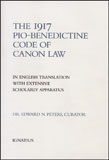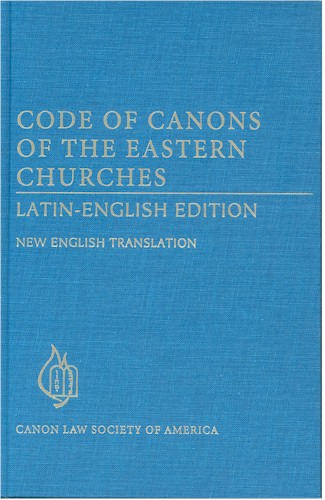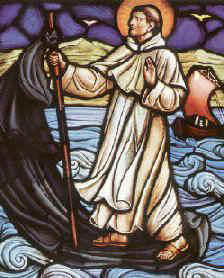|
To work for the proper implementation of canon law is to play an extraordinarily constructive role in continuing the redemptive mission of Christ. Pope John Paul II |
|
|
|
|
Resolution 1152 x 864 |
Updated 3 jan 2013 |
Liturgical Law: The Last Labyrinth |
|
Edward Peters, "Liturgical law: the last labyrinth", Adoremus Bulletin (Sep 1996) 3.
This, with some minor tweaks, turned out to be one of the most popular short articles I ever wrote. edp.
|
Canon 2, sitting quietly, almost
shyly, on the front porch of the 1983 Code of Canon Law, consists of two short
sentences:
In other words, faithful with liturgical questions probably ought not
look to the 1983 Code for answers because, with a few important exceptions,
canon law generally does not treat liturgical matters. But if liturgical law is
not found in canon law, where does one look for it?
Canon 2 of the Catholic Church's first comprehensive code read as
follows:
This is a clue? Granted, it's a bit more detailed than its 1983 successor, but it offers a nearly identical message: liturgical law is not canon law. Well, we already knew that, didn't we?
Yes, but it's precisely this striking similarity between the old and the new versions of Canon 2 which, for many reasons, requires us to explore very carefully what Canon 2 of the 1917 Code meant in its day in order to understand what Canon 2 of the 1983 Code means in ours. This slight, almost self-effacing Canon 2, which one might at first take simply as a bureaucratic decision-not-to-decide liturgical questions, carries tremendous implications for the modern practice of liturgical law and consequently for the faithful's experience of liturgical life in the Church. But to appreciate this point one needs to go back almost a hundred years to a time when canon law operated very differently from the way we know it now.
For nearly 1,900 years ecclesiastical law was not conducted under the aegis of a single authoritative code to which, more or less, most questions of Catholic discipline could be posed and answered. Rather, the religious and administrative norms of the Catholic Church were scattered over a veritable sea of papal and curial pronouncements, conciliar, patriarchal, provincial, and archdiocesan or diocesan decrees and regulations and instructions, baptized passages of Roman law, scholarly tracts taken as law, and commentaries on each of the above, followed by commentaries on the commentaries, and by commentaries on the commentaries on the commentaries.
To be applied in real life this mass of legal material, which covered whole walls and filled entire libraries, had to be assessed not just in its own right, but in the light of all the rest of the Corpus Iuris Canonici ("the Body of Canon law"), taking into consideration each provision's form and source of authority, its subject matter and intention, its date of issue and degree of specificity, its measure of acceptance and enforcement, and so on.
If
all this sounds maddening, it was.
Early Efforts to
Codify Church Law
But beginning in the 19th century the nation-states of Europe, whose legal systems were every bit as bulky as was the Church's, gradually turned to the technique of codification for relief from the morass which their laws had become. Their efforts, on the whole successful, were carefully watched in ecclesiastical circles, whose members began to recall similar organizing experiments in canon law dating back to the 12th century. Proposals to codify the body of canon law were made during the First Vatican Council but the collapse of the Papal States in 1870 and subsequent suspension of the council prevented further consideration of the idea at the time.
Thus, for one last generation as it turned out, Church law—be it canon, sacramental, liturgical, administrative, missionary, international, procedural, and so on—functioned as it had for centuries: a mass of maxims known but to a few and mastered by nearly none.
In the summer of 1903, though, Giuseppe Sarto became the only man this century elected pope who had extensive parish pastoral experience (17 years, to be exact). Pius X had grappled with Church law in the context which mattered most, the pastoral, and within one week of his election (some say one day), the future saint met with, Deo gratias, the greatest canon lawyer the Church had seen since the 13th century, Pietro Cardinal Gasparri, to discuss nothing less than the comprehensive codification of Church law.
The pope asked the canonist just one question: can it be done? The lawyer said it could, and 14 years later, Gasparri's distillation of nearly two millennia's worth of ecclesiastical legal wisdom was promulgated by Pope Benedict XV as the Catholic Church's first Code of Canon Law. The Church rejoiced and the world doffed its cap in genuine admiration. Gasparri had done it.
Or had he?
Well, it seems, not quite. Early in the process purporting to codify all Church law, Gasparri decided, for example, not to include Eastern canon law in the Code (1917 CIC 1). Likewise, international law as practiced by the Holy See was left out of the Code (1917 CIC 3), and only a light hand was applied to important areas such as "acquired rights" and "customs" (1917 CIC 4-5). The wide range of missionary law remained separate and under the direct supervision of the Sacred Congregation for the Propagation of the Faith, whose territorial responsibility, at the time, roughly equaled that of all other dicasteries combined.
Thus in several important domains of Church law the organizing principles of codification—and the assumptions about clear lines of authority and direct accountability that went with them—were not applied and each of these areas of Catholic life continued to function in almost exactly the same manner after the appearance of the 1917 Code as it had before.
Indeed, to this day, the fields
exempted by Gasparri in 1917 are still free of western codification, their
exclusions having been preserved by Pope John Paul II in the 1983 Code (1983 CIC
1 & 3-5). It was not until 1990, moreover, that Eastern Catholics received a
single codified set of canon laws. There is nothing wrong, of course,
with exempting various aspects of Church law from codification, though there is
nothing to prevent Church authority from bringing one or more of these fields
under the Code itself or codifying it independently (as was done, for example,
not just with Eastern law, but with the norms on canonization procedures or,
more recently still, papal conclaves).
Liturgical Law Left "Unmapped"
Which brings us back, at last, to Gasparri's largest exception to the great codification project: liturgical law, almost entirely exempted, as we have seen, from canonical purview in virtue of Canon 2. One can almost imagine Gasparri, at the outset of his great work, stepping into a huge hall lined from floor to ceiling with tracts on liturgical law, perhaps accompanied by his youthful assistant Eugenio Pacelli (later Pope Pius XII), and saying softly to himself, "No, I don't think we're quite up to this. Let's come back later." But later never came.
Of course, unlike the tiny cadre of clerics that makes up the Vatican diplomatic corps, or even the several millions of faithful under Eastern or missionary law, the number of Catholics directly and regularly affected by Roman liturgy soars into the hundreds of millions. To have exempted liturgical law, then, from codification in 1917 meant that it was to be conducted in essentially the same unwieldy and arcane manner as had been all Church law up till the 20th century. And the 1983 Code, as we have seen above, has expressly accepted this same attitude leaving liturgical law a field which few will understand and nearly none will master.
To point out the heavy significance of having exempted most of liturgical law from canonical codification is not to detract from the great legal and pastoral accomplishments which the Codes of Canon Law are, any more than one could fairly criticize Lewis and Clark for not having surveyed the American southwest. On the other hand, the explorers' map of Oregon, however remarkable, is not going to do one much good in the Arizona deserts and, if the Code may be considered a map for certain areas of Church discipline, then a widerness with only a little dramatic license, is an accurate analogy for liturgical law.
In fairness, it must be remembered that when Gasparri made his decision to omit liturgical law from his codification efforts he did so in the context of this times: liturgical life, for all practical purposes, was stable, and it had been for roughly two hundred years. The sacraments were celebrated in accustomed ways with recognized manners. Sacramentals and public devotional life followed well-worn paths. Language was consistent and unified, hymns were well known, worship times were predictable, dress codes were honored, and so on and so forth.
One may certainly admit deficiencies
in the liturgical world that functioned parallel to that of the 1917 Code, but
one must recognize the many strengths of that world as well. In choosing, for
whatever reasons, not to codify liturgical law, Gasparri could tell himself
that he was leaving undisturbed a large field that was already producing much
fruit in a fairly efficient manner.
Liturgy is a Jungle of Complexities
Today, of course, the world of liturgy has been thrown far off its axis. Examples of liturgical chaos are too exasperating to recite so instead consider this: if the only post-conciliar liturgical innovation had been to go from one western worship language (Latin) to well over 200 (which is precisely what happened in a few years), that change alone would have produced a hundred-year flood of confusion.
But that linguistic revolution was only a part of the thorough rewriting of the Mass itself, followed by the introduction of numerous variations on and options within the Mass, all coupled with a revamping of each of the individual sacramental rites. The liturgical calendar was redone, the norms on popular devotions and most sacramentals were reordered, and many new rituals and ceremonies were introduced (or, if one prefers, very old ones were suddenly and selectively restored). Many of these reforms have, of course, since been re-reformed, and there is no reason to expect that what increasingly seems like incessant liturgical tinkering will cease any time soon.
For all of these reasons, Canon 2, exempting most liturgical matters from canonical standards, portends much more serious consequences under the 1983 Code than it did under the 1917. Today, in order to answer confidently any but the most doctrinally core questions about liturgical practice, one must have access to and a command of:
If this all sounds maddening, it is.
The Problem Really Is the System
But by the same token, it goes a long way toward explaining why so many pew Catholics (though for that matter many Church officials as well) feel bewildered in their attempts to find out what licit liturgical practice currently is and why so many laity in particular are simply overwhelmed in their efforts to protect themselves against liturgical abuse.
Many times, to be sure, I have explained to people that what looked to them like liturgical violations were not in fact so and I could locate the documentation to satisfy them on the point. Other times, though, not even I have had the resources to demonstrate the liturgical illegality of what otherwise could only be described as bizarre and disruptive antics at the altar.
At the risk of sounding platitudinous, however, nothing in this article should discourage the faithful of any station in the Church from pursuing correct liturgy and striving for its establishment. To the contrary, a frank disclosure of the complexities involved should be a relief to those struggling in the field who perhaps have doubted their own abilities to understand the sources and issues involved. To them I say: it's not you, it really is the system. Strive on any way.
Remember that Canon 2 does not exempt all liturgical matters from canonical review only most of them. In some places,the clarity of the Code on liturgical questions is admirable and, in most such cases, it ends all reasonable debate as to what is acceptable and what is not. If confusion persists or deepens, the Holy See's Pontifical Council for the Interpretation of Legislative Texts may become involved. This Council consists of Cardinal prefects of other curial offices as well as a body of consultants-archbishops, bishops, and other clerics who are experts in canon law.
Remember also that a desire for correct liturgy is not simply a way of satisfying some psychological need for stability, but, as Canon 214 connotes, is a function of the faithful's "right to worship God according to the prescriptions of their own rite as approved by the legitimate Pastors of the Church." Remember above all that ecclesiastical laws are designed primarily to promote the salvation of souls (1983 CIC 1752) and so strive on in using them to accomplish such worthy ends.
In the meantime, one might also want to pray for the codification of liturgical law.
|




